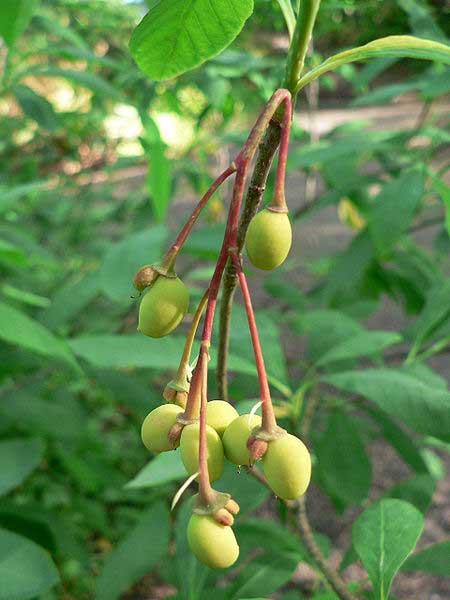
Oemleria cerasiformis (*)
Classification System: APG IV
Superregnum: Eukaryota
Regnum: Plantae
Cladus: Angiosperms
Cladus: Eudicots
Cladus: Core eudicots
Cladus: Rosids
Cladus: Eurosids I
Ordoo: Rosales
Familia: Rosaceae
Subfamilia: Amygdaloideae
Tribus: Exochordeae
Genus: Oemleria
Species: Oemleria cerasiformis
Name
Oemleria cerasiformis (Hook. & Arn.) J.W.Landon
References
Taxon; Official News Bulletin of the International Society for Plant Taxonomy. Utrecht 24:200. 1975
USDA, ARS, Germplasm Resources Information Network. Oemleria cerasiformis in the Germplasm Resources Information Network (GRIN), U.S. Department of Agriculture Agricultural Research Service. Accessed: 28-Oct-07.
Oemleria cerasiformis, a shrub commonly known as osoberry[4] or Indian plum,[5] is the sole species in genus Oemleria.
Native to the Pacific coast and ranges of North America, from British Columbia, Canada to Santa Barbara County, California, U.S.A.,[5] it is among the first plants to leaf out and flowers early in the spring. It reaches a height of 1.5–5 m and has lance-shaped leaves 5–12 cm long.
The fruits of osoberry are edible and resemble small plums which are dark blue when ripe.[6] Indigenous peoples of the Americas include osoberry in their diets, make tea of the bark, and chew its twigs to use as a mild anesthetic and aphrodisiac.[7]
Description
Osoberry is an erect, loosely branched shrub reaching 15 feet (4.6 m) in height. Leaves are alternate, simple, deciduous; generally elliptical or oblong, 2–5 inches (5.1–12.7 cm), light green and smooth above and paler below; margins are entire to wavy; fresh foliage smells and may taste like cucumber. Among the first plants to leaf-out in the spring. The plants are dioecious;[8] male and female flowers occur on different plants. The 5-petaled flowers are white or whitish-green, pendulous, about 1 cm across, and often appear in late winter before the leaves. The bitter-tasting fruit occurs in ovoid drupes up to 0.5 inches (1.3 cm) long, orange or yellow when young but blue-black when mature; borne on a red stem. The twig is slender, green turning to reddish brown, pith chambered, conspicuous orange lenticles. Bark is smooth, reddish brown to dark gray.[8]
Indian Plum is "shrubby"—often with multiple trunks and horizontal growth. Sagging branches that touch the ground root readily and separate, so large trees are often surrounded by genetic clones.
Uses
The wood is exceptionally strong and fine grained. With stems generally less than two inches [5 cm] in diameter, this small size limits the size of products that can be made from it. The fairly common straight shoots make fine primitive arrows and the rare, large enough and straight stem can be fashioned into an excellent self bow. It is also suitable for small wooden tools such as spoons, combs, knitting needles, etc. The fine grain and lack of significant figure also make the wood well suited for fine detail carving.
The Pacific coast tribes utilized its fruit, twigs, and bark, as food sources and for teas and medicine.[9] It is one of the first tree-borne fruits to ripen in summer and as such was prized by indigenous peoples and wildlife alike. Fruiting is highly variable, with sunny locations producing more, as well as larger and sweeter fruits. The fruits can be eaten raw, or cooked when bitter; they tend to be somewhat astringent.[9]
Images
Fruits of O. cerasiformis
An Indian plum shrub as its leaves begin to yellow in mid-summer, Pierce County, Washington
References
"The Plant List: A Working List of All Plant Species".
"The International Plant Names Index entry for Nuttallia Torr. & A.Gray ex Hook. & Arn".
"The International Plant Names Index entry for Osmaronia Greene".
BSBI List 2007 (xls). Botanical Society of Britain and Ireland. Archived from the original (xls) on 2015-06-26. Retrieved 2014-10-17.
"USDA PLANTS Profile: Oemleria cerasiformis".
Turner, Nancy J. (1995). Food Plants of Coastal First Peoples. UBC Press. p. 114. ISBN 9780774805339.
Pojar, Jim; Andy MacKinnon (2004). Plants of the Pacific Northwest. Lone Pine Publishing. p. 72. ISBN 978-1-55105-530-5.
"Oemleria cerasiformis Fact Sheet". Virginia Tech. Archived from the original on 2009-04-16. Retrieved 2009-03-06.
Nyerges, Christopher (2017). Foraging Washington: Finding, Identifying, and Preparing Edible Wild Foods. Guilford, CT: Falcon Guides. ISBN 978-1-4930-2534-3. OCLC 965922681.
Retrieved from "http://en.wikipedia.org/"
All text is available under the terms of the GNU Free Documentation License

